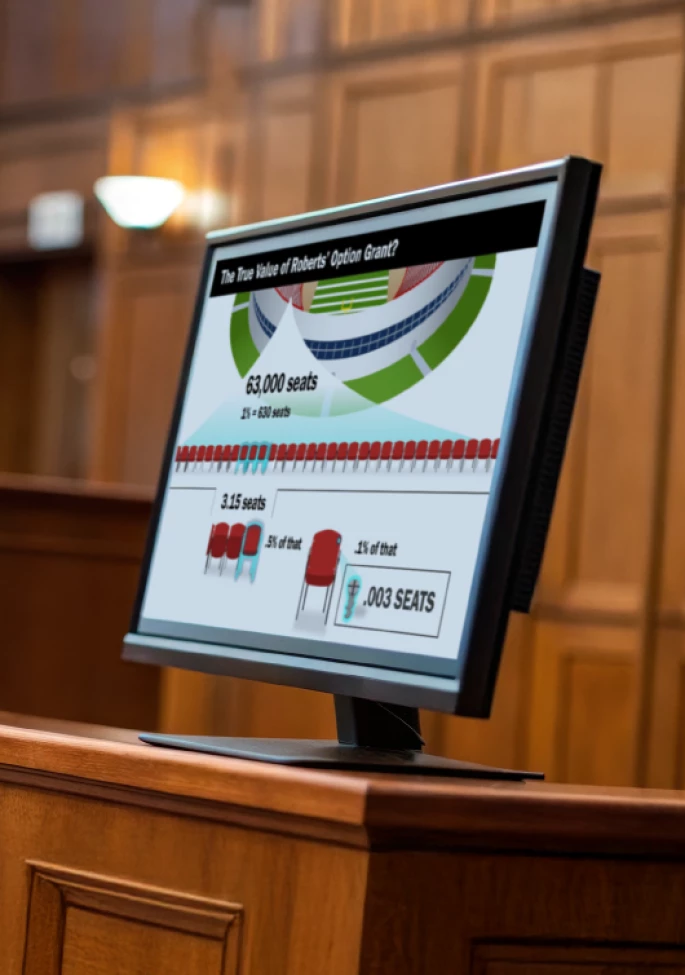Graphics are powerful because they have the ability to communicate more clearly and concisely than words. Depending on how that power is channeled, however, a graphic can either help or harm your case.
Expanding upon the essential tools we described in Part 3, the following tips can significantly improve the impact of your graphics at trial.
How to Maximize Your Graphics at Trial
Hire a Dedicated Trial Presentation Technician
Few, if any, lawyers are better at running graphics than a trained trial presentation professional. Moreover, a trial lawyer’s brainpower should not be focused on cueing up the next video or slideshow. Taking the use of trial graphics seriously means getting your client to pay for a presentation technician.
Create Graphics to Be Modular
Break your graphics into pieces that can be swapped out or deleted based on rulings at trial. No matter what you promise your client, you can’t predict a trial judge’s ruling with regard to any piece of evidence. Your graphics must therefore be constructed so that controversial topics or pieces of evidence can be removed immediately before opening or just as your primary witness is taking the stand.
This is why PowerPoint is very functional at trial. Your presentation technician, who is thoroughly familiar with your graphics, can remove or edit PowerPoint slides on demand. Foam boards can’t be fixed so quickly.
Tailor Graphics to Your Witnesses
If you have a weak expert witness, design your graphics to compensate for their particular limitations. For example, if your witness has a challenging accent, make sure your graphics highlight critical words or phrases that the jury may not pick out from testimony. If your witness has difficulty staying on topic, use bulleted lists to keep them focused.
On the contrary, if you are lucky enough to have a charismatic witness with a strong and pleasing voice, employ graphics only for the points you truly wish to hammer. Sometimes your best use of graphics is none at all.
Control Opposing Witnesses
Aggressive, showy opposing experts can be a handful; they will talk about anything but your question and hurt you as often as they can. By the end of their answer, the jury has forgotten what you even asked them.
However, displaying your question in “Yes/No” form as you ask prevents both the witness and jury from easily ignoring it and may clearly reveal a cagey expert is dodging your question. And since you shouldn’t be asking an expert any question that will yield a surprise answer, you should have prior testimony by this expert addressing each question you put in graphic form.
Having quotes from that testimony in graphic form on hand can highlight inconsistencies. This requires a great deal of preparation and organization (e.g., numbering quotes for you and your presentation tech’s reference) but can serve as a valuable tool to show the jury that the witness is singing a new tune. This preparation can boost your credibility while causing that of the witness to plummet.
Rehearse Your Presentation in Its Entirety
Regardless of what graphics you use and who runs the computer, it’s essential to test your full presentation. For example, if you have a timeline with multiple linked events and documents, practice the presentation on the computer that you will use in the courtroom. Minor differences in installed fonts and software settings can cause your presentation to lose polish in front of the jury—and a lawyer who looks at the display screen more than the jury is a lawyer who needs more rehearsal time.
While graphics wield great power in communicating themes to juries, it’s essential to remember that you, not the graphics, are the storyteller. The graphics are there to help guide you and your audience through your story.
Up Next
Our “Trial Graphic Fundamentals” series concludes with a look at trends in the field. Read Part 5 now.
This article series is based on a program originally presented to the International Association of Defense Counsel (IADC) by IMS Client Services Advisor Adam Bloomberg and Bryant Spann, Partner at Thomas Combs & Spann PLLC.







